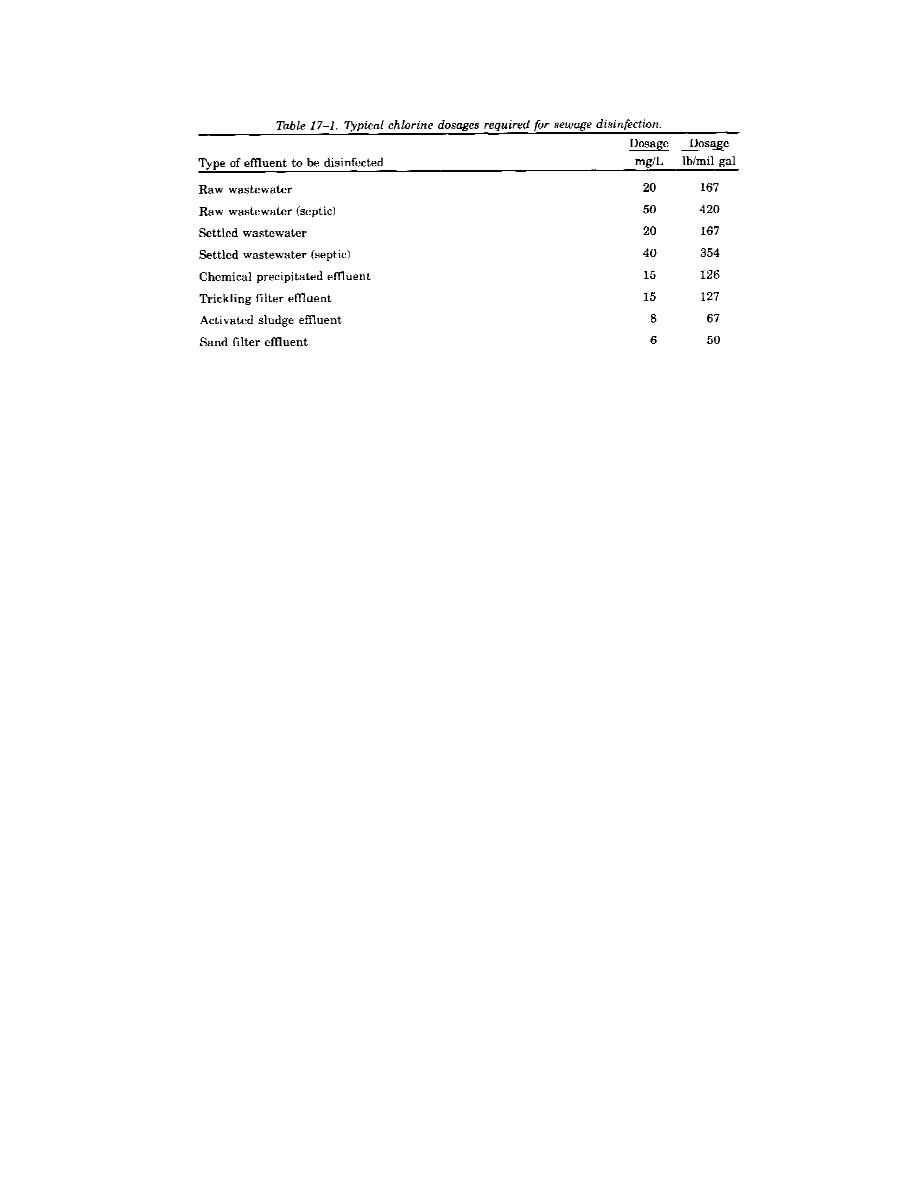
TM 5-814-3/AFM 88-11, Volume III
d. Use of hypochlorite. The use of hypochlorite compounds such as calcium hypochlorite and sodium
hypochlorite as a substitute for chlorine gas is usually justifiable for very small installations. Sodium
hypochlorite solution normally provides 12.5 percent available chlorine, and calcium hypochlorite solution
normally provides 65 percent available chlorine. To determine the equivalent dosages required for these
chemicals if used to disinfect the various types of effluents described above, divide the dosage figures by the
fraction of available chlorine attributable to the specific chlorine compound. Sodium hypochlorite is available
in solution form and calcium hypochlorite is available in solid form. Both calcium and sodium hypochlorite
shall be stored in cool, dry locations in corrosion-resistant containers.
e. Other chlorine uses. Chlorination of wastewater can reduce its biochemical oxygen demand by 15 to
35 percent; this is a common practice to relieve overloaded plants until additional capacity is provided.
Approximately 2 milligrams per liter of biochemical oxygen demand can be removed by 1 milligram per liter
of chlorine up to the point at which residual chlorine is produced. Odor control can be achieved by
prechlorination doses of 4 to 6 milligrams per liter. Odors from sludge drying beds can be reduced by
applying calcium hypochlorite at a rate of pound per 100 square feet of bed area. Periodic application of
chlorine in trickling filter influent will reduce filter clogging and ponding. A chlorine dose of 1 to 10
milligrams per liter, based on the returned sludge flow, is sometimes required for control of bulking sludge
in an activated sludge process. A chlorine residual of 1 milligram per liter in sludge thickener supernatant
prevents sludge from becoming septic during its holding period.
f. Mixing. Rapid mixing at the point of chlorine application is critical for disinfection efficiency, while
adequate mixing at the same point is critical for control puposes (see G.C. White, Handbook of Chlorination).
The following methods are acceptable mixing practices to be used at military installations: hydraulic jump,
submerged weir, over-and-under baffle, mechanical mixer, and closed conduit flowing full with adequate
turbulence. The design of the system should provide for addition of chlorine solution through a diffuser,
which may be a plastic or hard rubber pipe with drilled holes through which the chlorine solution can be
uniformly distributed into the path of flow of sewage; or it can flow directly to the propeller of a rapid mixer
for instantaneous and complete diffusion. Mixing by hydraulic turbulence for at least 30 seconds must be
maintained at or near the point of addition of chlorine solution to the sewage if mechanical mixing is not used.
17-3. Chlorine feeding equipment.
The chlorinator capacity will be designed to have a capacity adequate to provide the dosage requirement
stipulated in paragraph 17-2c at maximum flow conditions. Standby equipment of sufficient capacity will be
provided to replace the largest unit during shutdowns. Design considerations will be based on the assumption
that chlorine can be vaporized from 150-pound cylinders at a rate of 40 pounds per 24 hours, 30 pounds per
24 hours from 105-pound cylinders, and 450 pounds per 24 hours from 1-ton cylinders. Where greater rates
of feed are required, a suitable number of containers will be manifolded unless facilities are installed to
prevent chlorine system freezing due to evaporation. The use of 1-ton cylinders will be used where the
average daily chlorine consumption is over 150 pounds.
17-2



 Previous Page
Previous Page
